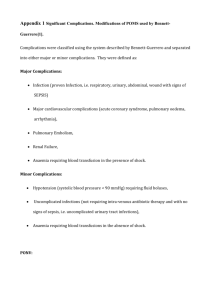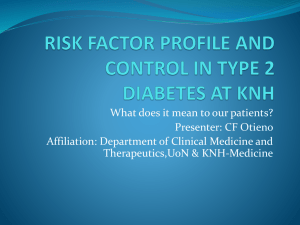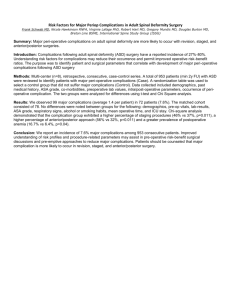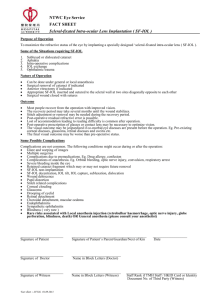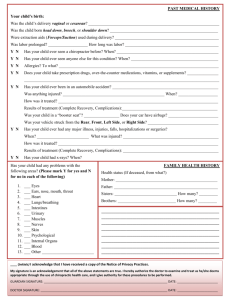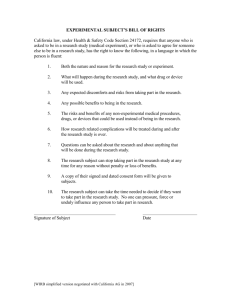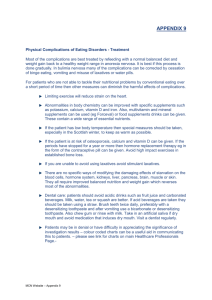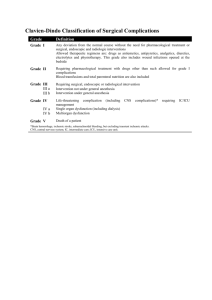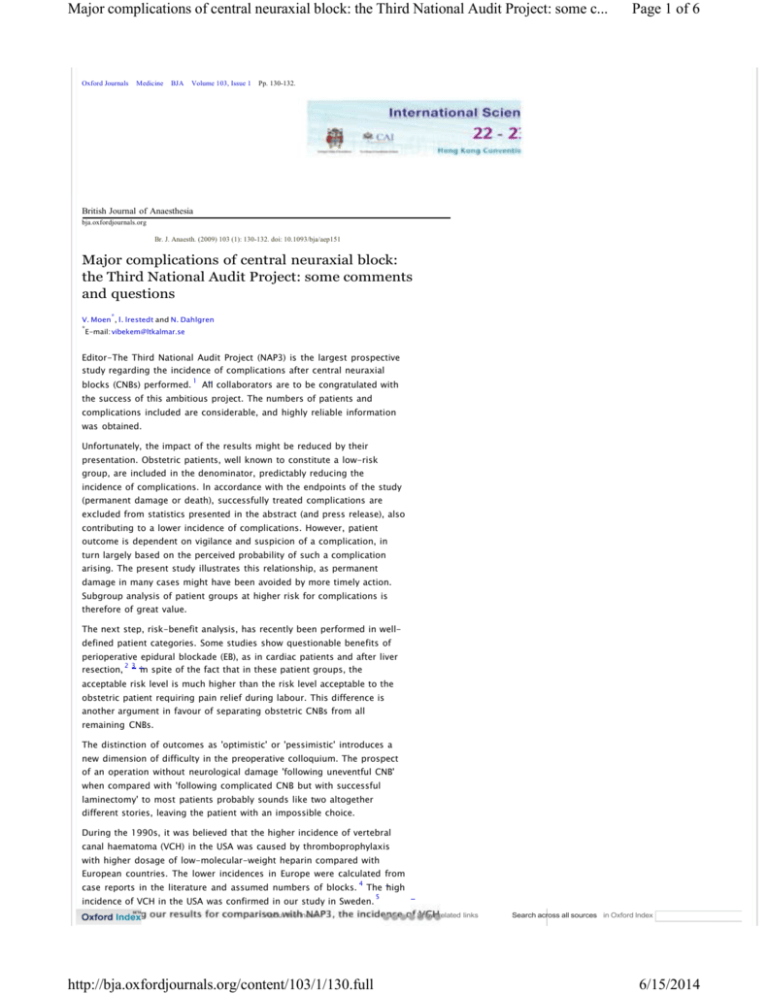
Major complications of central neuraxial block: the Third National Audit Project: some c...
Oxford Journals
Medicine
BJA
Volume 103, Issue 1
Page 1 of 6
Pp. 130-132.
British Journal of Anaesthesia
bja.oxfordjournals.org
Br. J. Anaesth. (2009) 103 (1): 130-132. doi: 10.1093/bja/aep151
Major complications of central neuraxial block:
the Third National Audit Project: some comments
and questions
*
V. Moen , l. lrestedt and N. Dahlgren
*
E-mail: vibekem@ltkalmar.se
Editor-The Third National Audit Project (NAP3) is the largest prospective
study regarding the incidence of complications after central neuraxial
blocks (CNBs) performed.
1
All collaborators are to be congratulated with
the success of this ambitious project. The numbers of patients and
complications included are considerable, and highly reliable information
was obtained.
Unfortunately, the impact of the results might be reduced by their
presentation. Obstetric patients, well known to constitute a low-risk
group, are included in the denominator, predictably reducing the
incidence of complications. ln accordance with the endpoints of the study
(permanent damage or death), successfully treated complications are
excluded from statistics presented in the abstract (and press release), also
contributing to a lower incidence of complications. However, patient
outcome is dependent on vigilance and suspicion of a complication, in
turn largely based on the perceived probability of such a complication
arising. The present study illustrates this relationship, as permanent
damage in many cases might have been avoided by more timely action.
Subgroup analysis of patient groups at higher risk for complications is
therefore of great value.
The next step, risk-benefit analysis, has recently been performed in welldefined patient categories. Some studies show questionable benefits of
perioperative epidural blockade (EB), as in cardiac patients and after liver
2 3
resection,
in spite of the fact that in these patient groups, the
acceptable risk level is much higher than the risk level acceptable to the
obstetric patient requiring pain relief during labour. This difference is
another argument in favour of separating obstetric CNBs from all
remaining CNBs.
The distinction of outcomes as 'optimistic' or 'pessimistic' introduces a
new dimension of difficulty in the preoperative colloquium. The prospect
of an operation without neurological damage 'following uneventful CNB'
when compared with 'following complicated CNB but with successful
laminectomy' to most patients probably sounds like two altogether
different stories, leaving the patient with an impossible choice.
During the 1990s, it was believed that the higher incidence of vertebral
canal haematoma (VCH) in the USA was caused by thromboprophylaxis
with higher dosage of low-molecular-weight heparin compared with
European countries. The lower incidences in Europe were calculated from
case reports in the literature and assumed numbers of blocks.
4
The high
incidence of VCH in the USA was confirmed in our study in Sweden.
About the Index
http://bja.oxfordjournals.org/content/103/1/130.full
5
Show related links
Search across all sources in Oxford lndex
6/15/2014
Major complications of central neuraxial block: the Third National Audit Project: some c...
Page 2 of 6
after non-obstetric perioperative EB was 1:10 200, compared with the
incidence of 1:19 500 in the NAP3. Female orthopaedic patients
constituted a high-risk group in the USA and in Sweden, in our study with
an incidence of VCH as high as 1:3800. The NAP3 does not define
numbers of orthopaedic EB, and it is unclear whether the use of
orthopaedic EB has diminished in the UK, as it undoubtedly has in Sweden,
after the results of these studies.
The discrepancy of complications in obstetric vs orthopaedic patients is
important not only for the application of CNB in everyday clinical practice,
but also for the understanding of the pathophysiology of the
complications. Specific pathology and non-specific age-related processes
6 7
cause narrowing and closing of the vertebral canal.
Consequently, in
the case of VCH in an elderly patient, the volumes causing symptomatic
compression may be inferior to those injected performing a blood patch
for treatment of post-dural puncture headache in the obstetric patient.
Magnetic resonance images show an epidural blood patch leaking through
the intravertebral foramina of young individuals,
with spinal pathology
9
8
but in an elderly lady
images show compression of the medulla caused
by local anaesthetic (and cerebrospinal fluid). This could have been the
pathophysiology behind some of the cases presented in the NAP3.
According to the press release covering NAP3, overall incidence of
complications was much lower than previously believed. This good news
would have been plausible, considering the possible impact of several
studies published in recent years. And indeed, compared with the overall
incidences of �1:1000 after perioperative EB reported by two recent
10 11
reports,
the incidences in the NAP3 are lower, even including
completely resolved cases.
However, the overall incidence of complications after perioperative EB in
NAP3 was almost identical to the incidence found in our study. ln NAP3,
26 complications associated with 97 925 perioperative EB (excluding one
cardiovascular collapse) and two complications after 16 525 combined
spinal-epidural (CSE) allow an incidence of 1:4000. ln Sweden, 63
complications in 245 000 perioperative EB (including CSE) account for an
incidence of 1:3880.
For the individual patient, there is little, if any, difference in probability of
developing a complication according to any one of these above-mentioned
incidences. But do the results of the NAP3 study really support the
conclusion that the risks are much lower than perceived? ln addition, the
verbal description of incidences probably influences future
anaesthesiologic practice more than naked numbers. Overoptimistic
interpretation of data might therefore retaliate, and that would be a sad
way to dissipate the results of this extensive and successful work.
*
T. M. Cook1, , D. Counsell2 and J. A. Wildsmith 3
+ Author Affiliations
*
E-mail: tcook@rcoa.ac.uk
Editor-We welcome Dr Moen and colleagues' interest in the Third National
Audit Project of the Royal College of Anaesthetists (NAP3).
1
lt is
particularly welcome because they are the authors of a widely quoted
5
study on the same topic. Their letter is long and there is not enough
space to address each issue raised in full here. ln addition, much of what
we might say was published in the full project report to which we would
refer them and other readers.
12
We believe that this is appropriate; the
article published in the British Journal of Anaesthesia stands on its own,
but it is primarily a quantitative analysis and precis of a very large audit,
and the report (freely available on the website of the Royal College of
12
Anaesthetists)
is a more discursive document.
Before addressing their letter in detail, it is perhaps worth commenting
About the Index
http://bja.oxfordjournals.org/content/103/1/130.full
Show related links
Search across all sources in Oxford lndex
6/15/2014
Major complications of central neuraxial block: the Third National Audit Project: some c...
Page 3 of 6
considerable international coverage, not a single enquiry from a journalist
was related to perioperative CNB. lndeed, our efforts to publicize those
results (which were included in all press releases) were repeatedly
thwarted by journalists, who reported exclusively on the project's
relevance to obstetrics. ln contrast, all the academic correspondence to
date has focused almost entirely on perioperative CNB. This dichotomy of
focus is worthy of reflection.
Dr Moen and colleagues raise numerous points, but we will respond only
to those relating specifically to the NAP3 results. They emphasize the
difference in the risk of complications associated with obstetric and
perioperative CNB. We quite agree, and that is why all NAP3 results are
12
presented by clinical indication. Further, in the full report,
the
complications relating to each clinical indication are discussed in a
dedicated chapter, each of which presents the quantitative data for CNB
performed for that indication. Differences in outcome according to clinical
indication are emphasized in the executive summary of the report and
elsewhere. Finally in Appendix 4 of the report, the full results (by
indication and type of CNB) are reported. Of note, we also emphasize
widely the pitfalls of comparing incidences between such groups without
considering case mix and other factors which make such groups
dissimilar.
like Fowler,
13
Moen and colleagues suggest that NAP3 underestimates the
incidence of complications because only complications leading to
permanent harm (defined as death or persisting deficit at 6 months after
CNB) were included. We agree that there will have been lesser complications
of CNB that were not notified to NAP3 and we also excluded
serious complications from which patients made a full and documented
recovery within 6 months. ln order to generate meaningful data from a
review of remote reports, it was important that NAP3 used a readily defined
and clinically meaningful outcome measure. NAP3 therefore did
not include neuropraxias (or other injuries) resolving at 6 weeks or 3
months, or indeed 6 months, but only those leading to persisting deficit at
6 months. NAP3 used a 6 month 'cut-off' and included all persisting
deficits, a definition of harm which was considered to be clinically relevant
to patients and anaesthetists. We accept that not everyone will agree with
14
this judgement. ln contrast to Moen and colleagues, Buggy's
accompanying editorial suggested that as some injuries may resolve
beyond 6 months, NAP3 may have overstated the incidence of
complications. NAP3 did not seek lesser or shorter lived complications and
we have no idea how many such complications occurred in our cohort. We
therefore intentionally did not analyse our results on this basis and we
discourage Moen and colleagues' analysis of our data because we believe
that it is not based on robust data capture or case analysis. For instance,
five of the 28 cases they refer to had almost complete or complete
resolution of symptoms even at the time of notification so were, at worst,
transient. Further, 10 (including these five) made a documented full
recovery within 6 months, and of the 28, only eight were included in the
optimistic interpretation of the data.
Moen and colleagues also take issue with the use of pessimistic and
optimistic interpretations of events reviewed by NAP3. This is discussed
both in the paper and the full report of the project and all review panel
members were in agreement with the decision to report the data in this
manner. All also agreed that the pessimistic interpretation was indeed
pessimistic. Of note, one of the authors considered that the term pragmatic
was a more accurate description of the second group, but it was ultimately
agreed to use the more cautious term optimistic. NAP3 reports all results
with both pessimistic and optimistic interpretation, and each with 95%
confidence intervals: addressing both clinical and statistical uncertainty. ln
practical terms, this provides clinicians with the opportunity to discuss the
data with each patient in as much detail as is appropriate.
About the Index
http://bja.oxfordjournals.org/content/103/1/130.full
Show related links
Search across all sources in Oxford lndex
6/15/2014
Major complications of central neuraxial block: the Third National Audit Project: some c...
Page 4 of 6
and pessimistic point estimates. Some anaesthetists may find this
confusing, but by presenting our data as fully and openly as possible we
enable clinicians to understand the origin and 'provenance' of the data. We
leave them to decide which figures they then choose to use in their clinical
practice. Whether the patient had a laminectomy or not was not a factor in
classifying outcome.
Moen and colleagues compare one of the point estimates of risk in their
study with one of the pessimistic point estimates of NAP3. The use of
point estimates rather than confidence intervals undermines this
comparison and both pessimistic and optimistic incidences should be
considered. Of note, many of the groups in their report had considerably
smaller denominators than those in NAP3, and the point estimates
therefore have wide confidence intervals. This applies particularly to those
15 16
with small numerators.
As discussed in both the paper and the full
report, Moen and colleagues place much emphasis on the apparently
higher risk associated with female orthopaedic (specifically knee
replacement) surgery. However, the apparently zero risk (from their
figures) in males undergoing hip replacement and the almost 10-fold
lower risk in females undergoing hip replacement are rarely commented on.
ln order for the comparison between the earlier figures and NAP3 to be
valid, the two studies must be methodologically very similar: although
NAP3 identified denominator data directly and completely, and sought to
identify permanent harm associated with CNB of whatever cause, their
study used more secondary calculations to determine denominators, and
the complications sought were primarily only neurological and appear to
have been less clearly defined. For instance, it is not clear whether cases of
spinal cord ischaemia or traumatic peripheral nerve injury were included
in their study and it is apparent that wrong route errors, cardiovascular
collapse, and drug overdose were not.
A further reason to be cautious about comparisons between these studies
is that the distribution of complications differs markedly. As an example,
in Moen and colleagues' paper almost 40% of complications were caused by
meningitis or cauda equina syndrome: these same complications
represent close to 7% of those reported to NAP3. Whether such differences
are historical or geographical is likely to be impossible to determine.
Finally, we have commented on the results of both Christie and
McCabe's
11
and Cameron and colleagues'
10
studies in our response to Dr
17 18
Grounds,
and also on the relevance of Wijeysundera and
19
colleagues'
study and how it complements the results of NAP3. These
are relevant here too and we reiterate our conclusion that relative to
previous studies, the results of the NAP3 project can, in the broadest
sense, be considered reassuring: even in the perioperative group. lt is
always difficult to marry population statistics (which NAP3 reports) with
individual clinical risk/benefit (as each clinician must for every patient);
this remains a daily challenge.
The NAP3 results should not replace previous estimates of risk associated
with CNB, but rather refine them. Although NAP3 does not provide a
definitive calculation of risk, because of its size and completeness we
believe that its estimates are at least as robust as any previously
published. lt is welcome when a study generates debate and we thank Drs
Moen and colleagues for their contribution to this debate, which no doubt
will continue within the pages of journals and coffee rooms of anaesthetic
departments.
References
1. Cook TM, Counsell D, Wildsmith JAW. Major complications of central neuraxial
block: report on the Third National Audit of The Royal College of Anaesthetists.
Br J Anaesth 2009;102:179-90.
Abstract/FREE Full Text
About the Index
http://bja.oxfordjournals.org/content/103/1/130.full
Show related links
Search across all sources
in Oxford lndex
6/15/2014
Major complications of central neuraxial block: the Third National Audit Project: some c...
Page 5 of 6
2. Hansdottir V, Philip J, Olsen MF, et al. Thoracic epidural versus intravenous
patient-controlled analgesia after cardiac surgery: a randomized controlled trial
on length of hospital stay and patient-perceived quality of recovery.
Anesthesiology 2006;104:142-51.
CrossRef
Medline
Web of Science
Search Google Scholar
3. Fazakas J, Toth S, Fule B, et al. Epidural anesthesia? No of course. Transplant
Proc 2008;40:1216-7.
CrossRef
Medline
Web of Science
Search Google Scholar
4. Tryba M. Ruckenmarksnahe Regionalanasthesie und niedermolekulare heparine.
Pro. Anasthesiol lntensivmed Notfallmed Schmerzther 1993;28:179-81.
CrossRef
Search Google Scholar
5. Moen V, Dahlgren N, lrestedt l. Severe neurological complications following
central neuraxial blockades in Sweden 1990-1999. Anesthesiology
2004;101:950-9.
CrossRef
Medline
Web of Science
Search Google Scholar
6. Szpalski M, Gunzburg R. lumbar spinal stenosis in the elderly: an overview. Eur
Spine J 2003;12 Suppl 2:S170-5.
CrossRef
Medline
Web of Science
Search Google Scholar
7. Usubiaga JE, Wikinski JA, Usubiaga lE. Epidural pressure and its relation to
spread of anesthetic solutions in epidural space. Anesth Analg 1967;46:440-6.
Medline
Search Google Scholar
8. Beards SC, Jackson A, Griffiths AG, Horsman El. Magnetic resonance imaging of
extradural blood patches: appearances from 30 min to 18 h. Br J Anaesth
1993;71:182-8.
Abstract/FREE Full Text
9. Jacob AK, Borowiek JC, long TR, et al. Transient profound neurologic deficit
associated with thoracic epidural analgesia in an elderly patient. Anesthesiology
2004;101:1470-1.
Medline
Web of Science
Search Google Scholar
10. Cameron CM, Scott DA, McDonald WM, Davies MJ. A review of neuraxial epidural
morbidity. Anesthesiology 2007;106:997-1002.
CrossRef
Medline
Web of Science
Search Google Scholar
11. Christie lW, McCabe S. Major complications of epidural analgesia after surgery:
results of a six-year survey. Anaesthesia 2007;62:335-41.
CrossRef
Medline
Web of Science
Search Google Scholar
12. Available from http://www.rcoa.ac.uk/index.asp?PagelD=717.
13. Fowler S. lncidence of severe complications after centroneuraxial block. Br J
Anaesth 2009;102:882.
FREE Full Text
14. Buggy D. Central neuraxial block: defining risk more clearly. Br J Anaesth
2009;102:151-3.
FREE Full Text
15. Hanley JA, lippman-Hand A. lf nothing goes wrong, is everything alright? J Am
Med Assoc 1983;259:1743-5.
Search Google Scholar
16. Newman B. lf almost nothing goes wrong, is almost everything all right?
lnterpreting small numerators. J Am Med Assoc 1995;274:1013.
CrossRef
Medline
Web of Science
Search Google Scholar
17. Grounds RM. ls the outcome for central neuraxial blockade really reassuring? Br J
Anaesth 2009;102:714-16.
FREE Full Text
18. Cook TM, Counsell D, Wildsmith JAW. ls the outcome for central neuraxial
blockade really reassuring? (Response). Br J Anaesth 2009;102:714-16.
FREE Full Text
19. Wijeysundera DN, Beattie WS, Austin PC, Hux JE, laupacis A. Epidural anaesthesia
and survival after intermediate-to-high risk non-cardiac surgery: a populationbased cohort study. lancet 2008;372:562-9.
d7
li1
ne- PW
eb
cie0n0c0
e7-0
Se9a1r2
ch Google Scholar
Online ICSro
SsNsR1e4f71M
-6e7
rin
t IoSf SSN
About the Index
http://bja.oxfordjournals.org/content/103/1/130.full
Copyright © 2014 the British Journal of Anaesthesia
gaalcN
qsuenintlO
y xA
uestions
Show related liC
no
ko
s kie PolicySeaLre
ch
roostsicaelsl soF
urre
ce
fosrkdeld
ndQ
ex
6/15/2014
Major complications of central neuraxial block: the Third National Audit Project: some c...
Page 6 of 6
© The Author [2009]. Published by Oxford University Press on behalf of The Board of Directors
of the British Journal of Anaesthesia. All rights reserved. For Permissions, please email:
journals.permissions@oxfordjournal.org
Other Oxford University Press sites:
Oxford University Press
About the Index
http://bja.oxfordjournals.org/content/103/1/130.full
Show related links
Search across all sources
in Oxford lndex
6/15/2014


